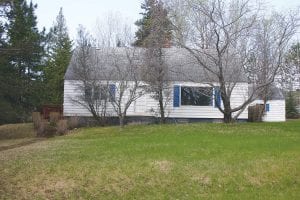One of the city’s last large pieces of mostly wooded private property stands to be cleared with five new houses erected and replacing one older home.
On May 9, the Grand Marais City Council voted 4-1 to allow variance to a minimum lot, which will allow five homes to be built on the former Howard and Rosemary Joynes property, which is located at the corner of 5th Street and 4th Avenue West in Grand Marais.
A public hearing was held April 30 with the Grand Marais planning board in attendance.
Kerry Boen, a local builder, requested the variance. Boen hasn’t purchased the property yet from Jim Joynes.
“The home was assessed for the possibility and practicality of revitalization,” said Joynes following the council meeting. “The feedback, from more than one builder, was less than encouraging. I wish that weren’t the case.
“A couple people have expressed an interest in buying the property, for various purposes. The council approved a well thought out plan, by one of the potential buyers. The plan is very impressive and it could help fill a need in the community. There are a number of details to be worked out. As of now, I still own the property.”
A letter objecting to the creation of a fifth lot was submitted to the planning commission by Neil Hansen and signed by him and two other neighbors, Jennifer Schulz, and Tom Turner. They noted that they had received notice of the public hearing on April 24, less than a week before it was scheduled.
In their letter, the neighbors expressed concern about the loss of trees, stormwater runoff and the location of the electric lines.
“While we certainly understand that Grand Marais is in need of more housing, and also understand that some development of the Joynes property is going to occur, the plight of the landowner, in this case, is not due to circumstances unique to the property. There are already enough frontages to allow Mr. Boen four lots. He is creating this situation by choosing to try to get more than exists out of what is there now.
“My neighbors and I believe that approving a substandard lot in order to get a fifth home in this small area is not in the best interests of the neighbors or the neighborhood.”
Another neighbor, Pete Gresczyk, who lives across the street from the Joynes property, asked if the houses would be used for short-term rental. He was told that in the R-1 zone the minimum term for rental is 30 days. Gresczyk also expressed a wish that the houses would not all look the same.
Despite the concerns outlined in the letter, the planning commission recommended approving the variance by a 4-0 vote. The most significant finding by the planning commission was, “The variance is in harmony with the purpose and intent of the ordinance. The variance would allow the property to be developed as residential housing as called for in the R-1 zone.”
Also noted by the commission was that the proposal would contribute to the much-needed shortage of housing in the community.
In their discussion about allowing the variance, time and time again what came up was that there is a current lack of housing in the area and the only way to keep new housing prices more affordable was building them close together.
“Density is the solution to affordability,” said Anton Moody, who is a contractor by trade. He added that he understood people’s concerns about building houses closer and closer together, but he added, “We can’t have people living here if they can’t find a place to live.”
Only councilor Kelly Swearingen, who grew up on the block, expressed reservations about the variance. In the end, Swearingen thought that four homes on the land would be enough and voted against the resolution.
Mayor Jay Arrowsmith DeCoux said, “If we don’t do a variance that space will be underused or not used for its intended purpose, housing.”
Conditional use permit approved
Next council took up the request by Carolyn Dry who requested a conditional use permit to operate an engineering research and testing business in a detached garage on her property zoned R-2 Multi-Family Residential, which is located at 406 Second Avenue East.
As part of her request, she asked that the workers she hired be allowed to reside in the existing multi-family house on the premise. Dry will operate her business for two months and three weeks this summer, “as an experiment to see if this area that I love can be a location for my small business,” she wrote in her application.
After the application was reviewed, it was approved by the planning commission and forwarded to the city council, which also approved it. The neighbors around Dry mostly voiced support for the business with one saying she couldn’t support Dry’s request without knowing more information. Although no one on the council knew what Dry would be making, the councilors voiced support for Dry’s attempt to start a technology company in the city and hoped it would be something that could grow into a year-round business.
In other business:
Mayor Jay Arrowsmith DeCoux said a survey was being sent to downtown business to see if there was interest in allowing first floor (storefront) housing/rental in the downtown area. He said the city’s new communication director Patrick Knight would be assisting with this project.



Leave a Reply